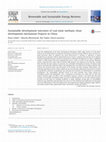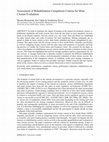Papers by Mascha Blommerde

Since the establishment of the Clean Development Mechanism (CDM) under Article 12 of the Kyoto Pr... more Since the establishment of the Clean Development Mechanism (CDM) under Article 12 of the Kyoto Protocol to the United Nations Framework Convention on Climate Change (UNFCCC) there has been on-going discussion about its potential and actual effectiveness in assisting in reductions in global greenhouse gas emissions. Projects implemented in non-Annex 1 countries have had the aim to mitigate emissions of greenhouse gases and also to contribute to sustainable development. In China, a significant number of CDM projects have been implemented across a range of sectors of the economy. Although various evaluations have been made of Chinese CDM projects, one industrial sector that has received little attention has been mining. In particular, the sustainable development outcomes of Chinese CDM projects associated with methane capture and utilisation from coalmines have not been evaluated. This research has involved review and assessment of 30 Chinese coalmine methane CDM projects. The evaluation approach involved content analysis of coalmine methane CDM project documents in relation to quantitative reductions of greenhouse gas emissions and indicators of contributions to sustainable development. The sustainability indicators found to be most prevalent were safety, energy use, technology transfer and employment. Also a comparison of outcomes was made with six coalmine projects initiated under the CDM in other developing countries. Overall, it was found that only brief accounts of sustainable development goals are given in CDM documents for coalmine methane project activities and that these are arguably insufficient in detail. Although varying types of sustainability initiatives were identified, many potential areas were not. These findings have implications for the future success of CDM projects in the coalmining sector, the proposed new market mechanism under UNFCCC and similar projects being implemented under mechanisms outside the UNFCCC.

In order to minimise the impact of mining on the natural environment, closure rehabilitation
legi... more In order to minimise the impact of mining on the natural environment, closure rehabilitation
legislation and bond systems have been put into place in most regulatory environments
in developed countries. Success criteria (e.g. soil, water, flora and fauna) are established
for mine closure plans and codes of practice for such regulations. Mining companies are required
to abide by these criteria to have their bonds refunded and leases relinquished by government.
This paper looks into the closure criteria in New South Wales, Australia, specifically,
as well as comparing closure criteria with the other states and territories in Australia, and leading
practice in Canada, the United States and European Union. The research for the paper involves
investigation of rehabilitation success criteria and the possible evaluation of mine closure
success. This study has highlighted the need for stronger guidance and key requirements for closure
success. A stronger framework is therefore needed to quantify the different rehabilitation
success criteria to be able to attain a well-documented evaluation of mine closure success. Robust
quantification of the completion criteria, if verifiable, could assist mining companies as
well as regulatory bodies to achieve best possible outcomes. Further research into key requirements
of the closure criteria as well as a closure framework or tool is recommended.






Uploads
Papers by Mascha Blommerde
legislation and bond systems have been put into place in most regulatory environments
in developed countries. Success criteria (e.g. soil, water, flora and fauna) are established
for mine closure plans and codes of practice for such regulations. Mining companies are required
to abide by these criteria to have their bonds refunded and leases relinquished by government.
This paper looks into the closure criteria in New South Wales, Australia, specifically,
as well as comparing closure criteria with the other states and territories in Australia, and leading
practice in Canada, the United States and European Union. The research for the paper involves
investigation of rehabilitation success criteria and the possible evaluation of mine closure
success. This study has highlighted the need for stronger guidance and key requirements for closure
success. A stronger framework is therefore needed to quantify the different rehabilitation
success criteria to be able to attain a well-documented evaluation of mine closure success. Robust
quantification of the completion criteria, if verifiable, could assist mining companies as
well as regulatory bodies to achieve best possible outcomes. Further research into key requirements
of the closure criteria as well as a closure framework or tool is recommended.
legislation and bond systems have been put into place in most regulatory environments
in developed countries. Success criteria (e.g. soil, water, flora and fauna) are established
for mine closure plans and codes of practice for such regulations. Mining companies are required
to abide by these criteria to have their bonds refunded and leases relinquished by government.
This paper looks into the closure criteria in New South Wales, Australia, specifically,
as well as comparing closure criteria with the other states and territories in Australia, and leading
practice in Canada, the United States and European Union. The research for the paper involves
investigation of rehabilitation success criteria and the possible evaluation of mine closure
success. This study has highlighted the need for stronger guidance and key requirements for closure
success. A stronger framework is therefore needed to quantify the different rehabilitation
success criteria to be able to attain a well-documented evaluation of mine closure success. Robust
quantification of the completion criteria, if verifiable, could assist mining companies as
well as regulatory bodies to achieve best possible outcomes. Further research into key requirements
of the closure criteria as well as a closure framework or tool is recommended.